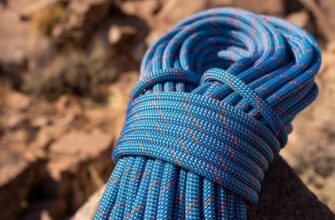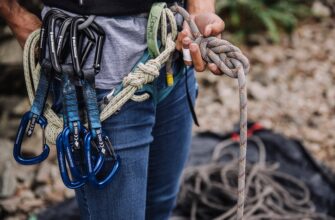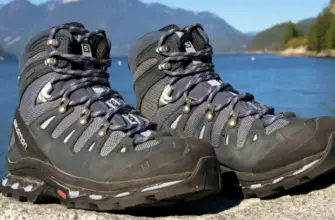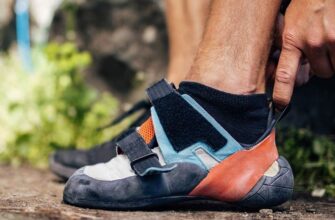How to choose climbing rope diameter? Buying a rock climbing rope requires taking into account a plethora of factors.
The most important — and frequently the most difficult — factor to take into account is what diameter climbing rope you should get.
Key aspects of rope diameter are broken down below, including the optimum applications for different widths, rope handling, elongation, durability, and more.

- A climbing rope features
- Modern climbing ropes
- So what is climbing rope diameter?
- Redpointing, multi-pitch, mountaineering, and ice climbing/alpine climbing: 8.5mm to 9.3mm climbing rope
- Crumbling, top-roping, and multi-pitch: 9.4mm to 9.7mm climbing rope
- Cragging, top-roping, and gym climbing: 9.8mm–10.2mm climbing rope
- What diameter is a grigri rope?
- How do I choose a rope diameter for climbing?
- Handling a climbing rope
- Elongation
- Durability
- Belay equipment compatibility
- Skinnier ropes: do you need one?
- Twin ropes and half ropes
- Rope management and care
- At the crag
- At home
- FAQ
- What is the best thickness for climbing rope?
- Thicker climbing ropes (9.8 – 10.5 mm)
- Thinner ropes (9 to 9.5 mm)
- In conclusion
A climbing rope features
As climbers, we are fortunate to have the technologies we do today. Falling is made safe and thrilling by the use of flexible, soft ropes. So much so that deliberate falls known as “victory whips” are a thing! This wasn’t always the case, though.
Ropes composed of hemp and flax were employed by early alpinists, but they were far less resilient than current ropes.
Additionally, because of their design, they weighed more and twisted uncomfortably when in use.
Most significantly, early climbing ropes lacked any kind of dynamic movement. They may easily result in harm because they would not be able to absorb the impact of a fall.
In this age, climbers only needed to develop a “do not fall” mentality.
Modern climbing ropes
Thankfully, the era of inferior climbing rope is over. Today, climbers can choose from a wide range of choices from numerous rope manufacturers. As niches in the climbing community have grown, so too have specialized ropes designed to shine in various contexts.
The options available presently include single ropes, half and twin ropes, dynamic ropes, static ropes for pulling and rappelling, and climbing ropes of various diameters.
There are advantages and disadvantages to various rope systems. Static ropes that are thick, for instance, weigh more but are typically more durable than a thinner climbing rope.
Moreover, you should take into account such characteristics as climbing rope length, rope markings, dry treatments, etc. Climbing rope length, for instance, determines how far you can climb before you have to create an anchor and how long you can rappel. The typical climbing rope length is 196 ft.
The ideal ropes for the various climbing disciplines will be covered in more depth below. The UIAA (International Climbing and Mountaineering Federation) should certify all climbing ropes.
They should have these safety ratings on both ends when new. This indicates that it has undergone professional testing to guarantee that the rope stretches sufficiently. And when the rope stretches enough it can withstand the force created by a serious fall.

So what is climbing rope diameter?
The climbing rope diameter is a crucial factor that affects aspects of climbing.
Because climbing rope diameter affects performance so great, many climbers maintain a quiver of ropes for various applications. There is a medium-diameter rope for challenging projecting, a thick rope for top-roping, a thin line for alpine climbing, an old fuzzy rope for the gym, etc., as well as a setup of double ropes for three-people climbing.
We’ve included what we believe to be the ideal rope diameter for each practice below.
Redpointing, multi-pitch, mountaineering, and ice climbing/alpine climbing: 8.5mm to 9.3mm climbing rope
These ropes, sometimes known as “thin ropes,” are typically employed in multi-pitch, sport climbing, mountaineering, and ice climbing situations where the weight of the rope can quickly build up.
However, a thinner climbing rope can slide more easily through carabiners, belay devices, and rocks, necessitating a more experienced belay and greater caution than ropes in the categories below. Naturally, thin ropes are far less resilient than thicker ones.
A stronger rope would be a much safer choice if you intend to do a lot of top-roping or take numerous falls when projecting a route for sport climbing or alpine climbing. However, if you’ll be pulling the crux of your project or climbing thousands of feet in a single day, a thin and light rope can make all the difference.

Crumbling, top-roping, and multi-pitch: 9.4mm to 9.7mm climbing rope
For the greater part of climbers, medium-diameter ropes — or ropes in the mid-9mm range — are the most adaptable choice. This is our suggested rope for newcomers to the sport who desire one rope for both multi-pitch and crag outdoor climbing.
A rope with a medium diameter creates a wonderful mix between toughness and weight, and its moderate stretch provides just enough bounce for a lead fall without significantly reducing top-roping performance. A rope in this category also provides better handling and more durability than a slender rope.
Cragging, top-roping, and gym climbing: 9.8mm–10.2mm climbing rope
We’ll be honest, many people are not huge fans of fat ropes though they are very popular for gym climbing.
Ropes with a diameter of 9.8mm and greater are becoming less and less common and for good cause.
Nowadays, medium-sized ropes provide comparable levels of durability at lighter weights and compare price ranges. Additionally, fat ropes fall short in terms of how they behave in a belay device; a 9.8mm rope that hasn’t been used much may even be challenging to pass through a Grigri.
Nevertheless, thick ropes are still useful in some situations. Thick ropes are a reliable workhorse if you frequently top-rope (particularly in places with jagged rock), practice gym climbing, or are on a low budget. However, 10.2mm is likely the maximum amount of weight you would ever want to reach.
What diameter is a grigri rope?
The Grigri is equally effective for top roping and lead climbing. They are safe as ropes as thin as 8.5 mm and as thick as 11 mm, but they work best as 8.9 to 10.5 mm single dynamic ropes.
The Grigri dynamic rope will travel with you on climbs all over the world for many years because it is small and incredibly light.
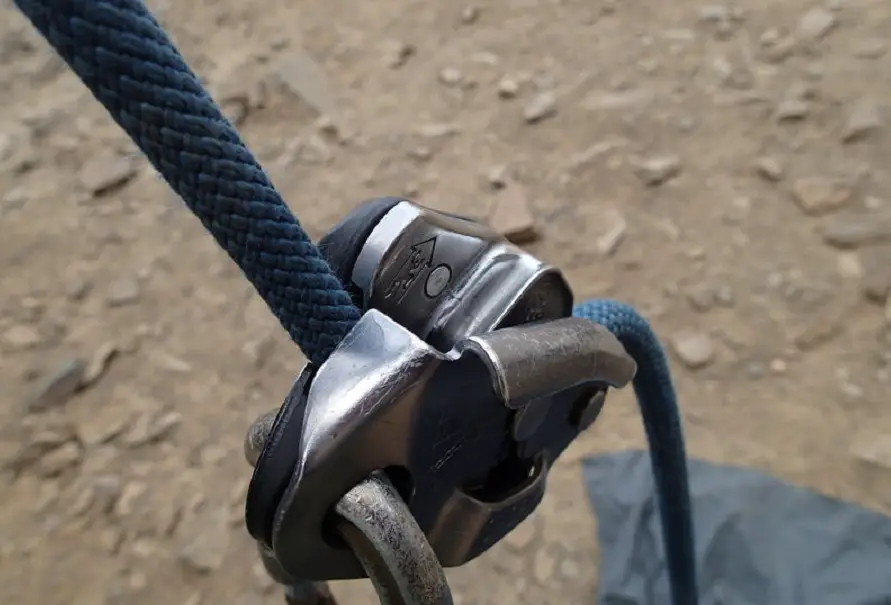
How do I choose a rope diameter for climbing?
Handling a climbing rope
A rope’s feel, including how soft or firm it is, how it slides through the belay device, coils, stacks, and pulls from the chains, are all aspects of rope handling. Rope diameter is one of several elements that affect how effectively a dynamic or static rope behaves.
A rope is more difficult to pull and more likely to twist and form knots the skinnier it is. A thinner rope also causes less friction in the belay system. Larger ropes, on the other hand, may produce excessive friction in belay devices, making it challenging to release or take in slack.
Additionally, the weight and mass they add might build up, making it harder to control the rope. Overall, we believe that mid-9mm ropes provide the best handling.
Elongation
A climbing rope will expand to some extent when weight is added to it, whether it is from a top-rope fall or a lead fall. The rope’s static or dynamic elongation is what is meant by these terms. In general, thinner ropes exhibit more static and dynamic elongation than thick ones.
This kind of stretch is preferable for experienced climbers pushing their limits and taking lead falls since it enables a gentler catch and exerts less power on the rock and equipment. However, a rope with less elongation is desirable in all top-rope situations.
Having said that, all climbing ropes should have a certain elongation, dynamic climbing ropes are advised. Always climb on dynamic climbing ropes. But static climbing ropes are often used for jugging, hauling, and fixed-line situations, as well as for setting up anchors in single-pitch conditions.
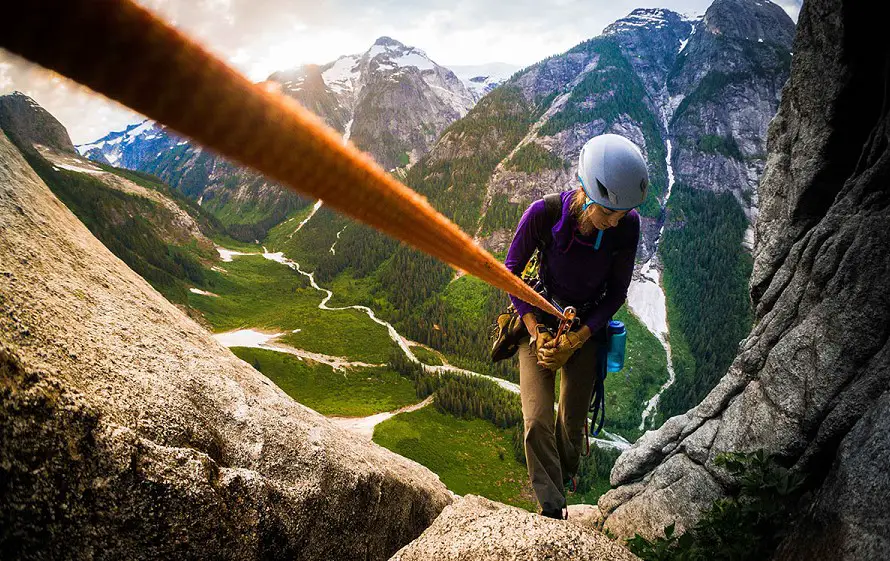
Durability
Skinny ropes nowadays are stronger and more resilient than ever thanks to advancements in rope technology, including creations like Beal’s Unicore, which fuses a rope’s outer sheath and inner core. But even so, it seems to reason that a thick one will automatically be more durable, all things being equal.
To be clear, we are not implying that thin climbing ropes are dangerous — all common climbing ropes are UIAA certified and incredibly robust. A slender rope contains less material, which means less redundancy, but the little things can add up.
Because of friction, repeated lead falls, and jagged rock, the rope can weaken more rapidly than a thicker rope.
In other terms, a thicker rope can withstand more force and falls. All things considered, quality also affects durability, so be sure to get a well-made rope from a renowned manufacturer.
Belay equipment compatibility
A belay (or rappel) equipment is always used in conjunction with a rope. And each device has a preferred range of rope widths that it can handle.
It is recommended to examine these parameters before use because they are easily accessible from manufacturers. The majority of equipment can handle the complete range of rope widths.
Additionally, if you use tube-style gear, you can increase friction by passing the rope through two carabiners rather than just one.
Skinnier ropes: do you need one?
In climbing, skiing, and many other outdoor activities, it’s simple to get sucked into the “light is right” movement.
However, in general, you don’t need the most cutting-edge equipment if you’re just starting in the sport.
Skinny ropes are undoubtedly useful for high-level alpinism and redpointing, but a skinnier rope is detrimental to all other climbing techniques. Don’t misunderstand us; we’re not attempting to discourage seasoned climbers from using that one rope, and we personally frequently use sub-9mm ropes.
However, we advise staying in the mid-9mm range and higher for the average climber.
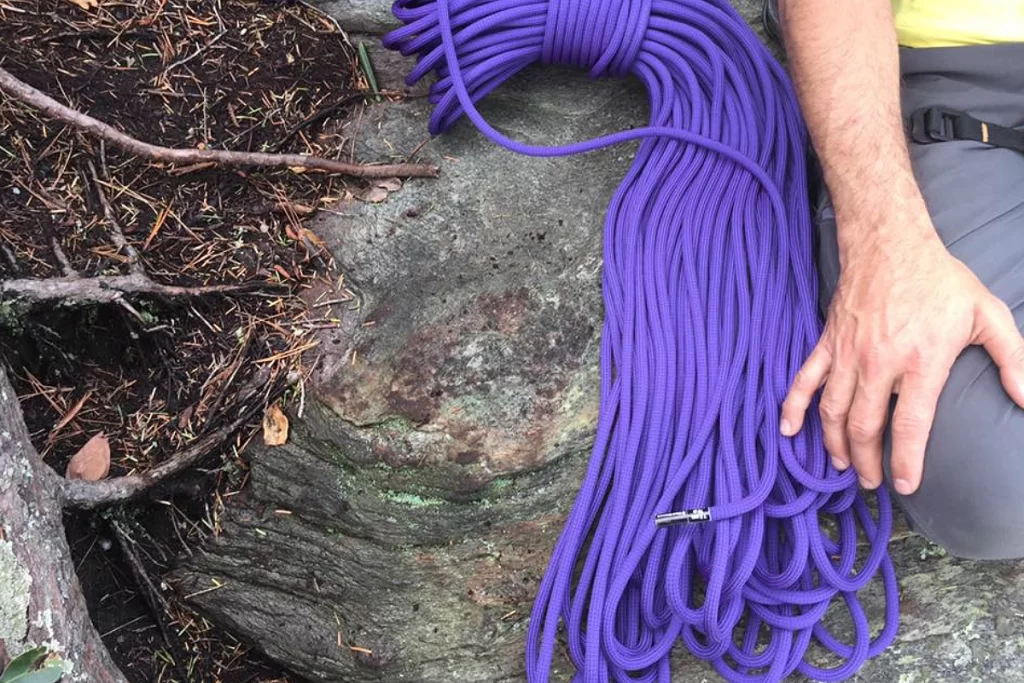
Twin ropes and half ropes
If you’re a novice to the sport, it’s your first climbing rope and you would like to try top-roping or single rope lead climbing at your nearby crag, you’ll need a single rope since the majority of climbers in the US choose a single rope. But in other situations, using two ropes — or double ropes — is the most practical or secure choice.
Double ropes are advised for multi-pitch climbing and ice climbing, as well as for routes that require wandering a lot (to reduce rope drag), and climbs that need two ropes to rappel, single ropes are not recommended.
Double ropes are divided into two primary categories: half ropes and twin ropes, and are often thinner than their single rope counterparts, while a single rope can also be rated as a double rope.
The difference between the half ropes and twin ropes is crucial, and climbers must fully comprehend how to use their double ropes properly before choosing between half ropes and twin ropes. Finally, unless it is rated to do so, never utilize double single ropes as a single rope.

Rope management and care
At the crag
If you treat a rope well, it will last much longer. With dirt, sand, and other particles, a rope can be destroyed quickly. Small objects have the potential to penetrate the rope and damage the softer inner strands of the core.
Do not tread on the rope! Sand and other debris can be gathered by rock climbing shoes, which can subsequently be ground into the rope.
Purchasing a rope bag will prevent the rope from coming into contact with the ground.
Watch out for jagged edges while climbing and try to keep the rope from rubbing against them.

Consider taking a piece of hose or PVC that you can drape over the rope to protect it if it runs over an edge of top roping and it is necessary. Check carabiners and belay equipment for burrs that could harm your rope regularly.
Weighted ropes should never be fastened to webbing directly; always use carabiners. A sling can be cut through with just a few meters of weighted rope going through it thanks to the heat it generates. At the end of the day, regularly check your rope to make sure it is undamaged.
At home
Always keep your rope in a cool, dry location away from the sun. If a rope is kept in a humid atmosphere for storage, even a dry-treated rope can swiftly deteriorate.
Keep your rope away from dirt and dust, just like at the crag, as these can seep into the sheath and harm the rope from the inside out. Hanging your rope from the wall — where there isn’t much dust flying around — is a common choice.
Wherever you climb, it could be advantageous to occasionally wash your rope. This will not only make the rope appear clean, but it will also increase its lifespan by removing dirt particles, and after everything is said and done, the rope will be lighter.
Take care of your ropes’ condition. Before a rope is completely retired, it is frequently still viable to utilize it for activities like fixed ropes or top rope climbing. Be aware that thicker ropes typically outlast thinner ropes. If a rope becomes fuzzy, you shouldn’t use it for any climbs where a serious fall is possible.
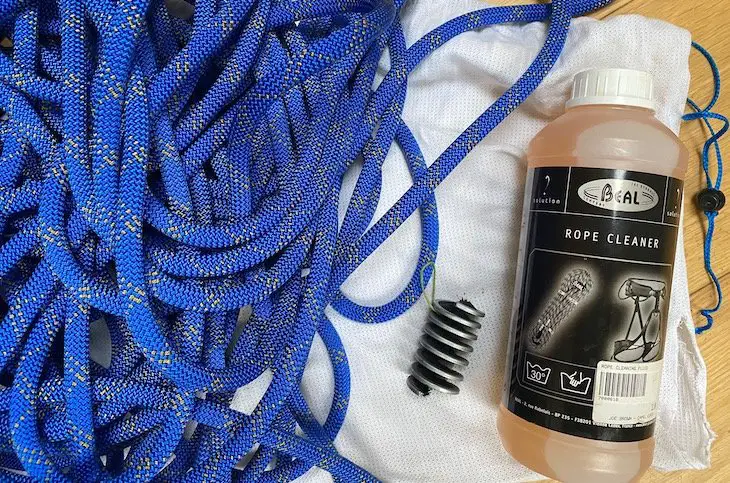
FAQ
What is the best thickness for climbing rope?
Between 9.5 and 10 mm is the ideal diameter for all-purpose single climbing ropes. Thicker ropes are easier for novices to manage since they produce more friction and are more abrasion-resistant.
Advanced climbers might benefit more from using thinner ropes (diameter 9 mm), which are lighter and produce less rope drag.
Thicker climbing ropes (9.8 – 10.5 mm)
Many climbers begin with a bigger rope and then upgrade to thin ones as their climbing and belaying abilities advance.
Thinner ropes (9 to 9.5 mm)
In terms of lead climbing for sport, we wouldn’t go below 9.4 mm. This rope will be thin and flexible, yet strong and friction-friendly.
In conclusion
As we previously stated, there are many excellent ropes available for all varieties of climbing. There is no one “best climbing rope” because there are so many different types. Don’t stress too much about making the ideal decision or details like climbing rope weight if you are new to rock climbing. Purchase a sturdy, strong rope instead so you can practice the fundamental moves.
Do your research in advance if you are a more seasoned climber looking for a rope to suit a certain climbing style. If at all feasible, speak with other climbers who are familiar with the route or the location(s) you intend to visit.



